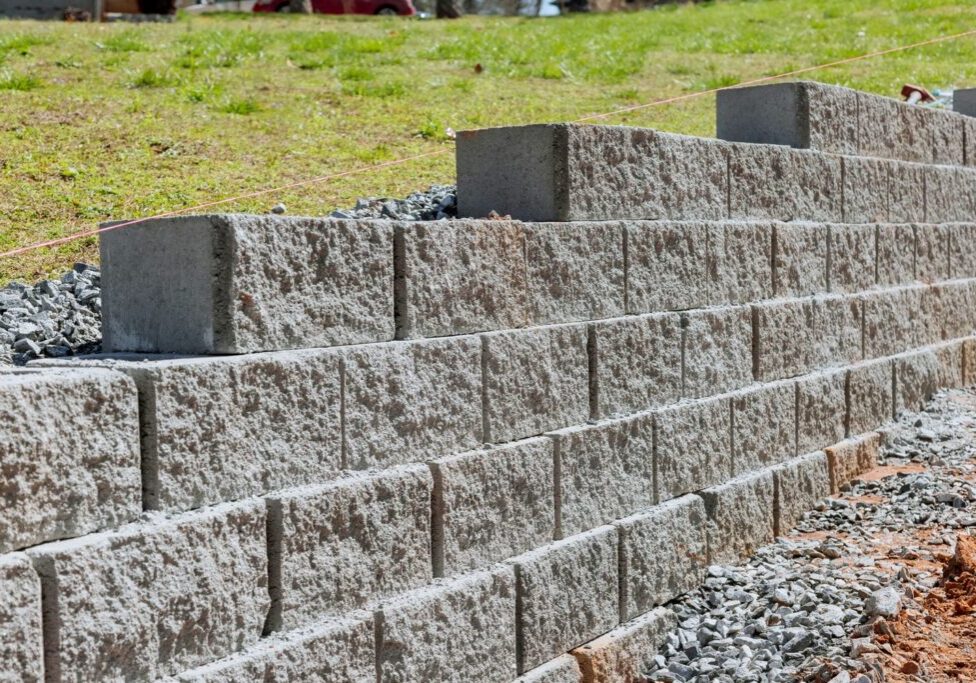
Retaining walls are essential features in many landscapes, providing both functionality and aesthetic appeal. They prevent soil erosion, manage slopes, and create usable space in challenging terrains. However, a critical component of retaining wall stability often goes unnoticed: proper drainage. Without effective drainage, even the most well-constructed retaining wall can fail over time, leading to costly repairs or even total collapse. Let’s dive deeper into why drainage is crucial, how it impacts the longevity of your wall, and the key considerations to keep in mind during installation.
Why Drainage Matters for Retaining Walls
Retaining walls are designed to hold back soil and prevent erosion, but they must also contend with one of nature’s most persistent forces: water. When water accumulates behind a retaining wall, it creates hydrostatic pressure—a powerful force that can push against the structure and compromise its stability. Hydrostatic pressure increases dramatically when water has no outlet, turning even a well-built wall into a liability over time.
Proper drainage allows water to flow away from the wall, relieving this pressure and preserving the wall’s integrity. Without adequate drainage, issues such as bulging, cracking, or leaning are almost inevitable. Waterlogged soil becomes significantly heavier than dry soil, exerting additional strain on the wall. Over time, this excess pressure can weaken the wall’s foundation and lead to structural failure. By integrating an effective drainage system, you’re not just improving performance but also safeguarding the longevity of your investment.
Key Drainage Features for Retaining Walls
To ensure proper drainage, several critical components must be incorporated into the design and construction of a retaining wall. These features work together to direct water away from the structure and prevent damage:
- Gravel Backfill: A layer of gravel behind the wall creates a permeable barrier that facilitates water movement. Unlike compacted soil, gravel doesn’t retain water, allowing it to flow freely and reducing the risk of hydrostatic pressure building up against the wall.
- Drain Pipes: Perforated drain pipes, often referred to as weep holes, are installed at the base of the wall to guide water away from the structure. These pipes provide a controlled outlet for excess water, preventing it from accumulating behind the wall and causing damage.
- Filter Fabric: A layer of filter fabric placed between the soil and gravel helps prevent soil particles from clogging the drainage system. This simple yet effective feature ensures that water flows smoothly while maintaining the structural integrity of the wall.
- Proper Grading: Grading the area behind the retaining wall is essential to directing water flow. By sloping the ground slightly away from the wall, you can reduce the amount of water that accumulates behind it, minimizing hydrostatic pressure and prolonging the wall’s lifespan.
- Surface Drainage Systems: In addition to addressing water behind the wall, managing surface water is equally important. Installing swales, gutters, or other drainage systems around the retaining wall can further reduce the amount of water that reaches its base.
Signs of Poor Drainage
If a retaining wall lacks proper drainage, the warning signs are often visible. Recognizing these issues early can save you from more extensive damage and repairs. Common signs of poor drainage include:
- Bulging or Bowing: Sections of the wall may appear to bulge outward, indicating excessive pressure from water accumulation.
- Cracks and Gaps: Cracks along the surface or foundation of the wall are telltale signs of structural stress.
- Pooling Water: Water collecting at the base of the wall or in surrounding areas is a clear indication that drainage systems are inadequate or failing.
- Leaning or Tilting: Walls that lean forward or appear unstable often suffer from excessive hydrostatic pressure due to poor drainage.
Addressing these issues promptly is essential to preserving the structural integrity of the wall and avoiding costly repairs.
How Proper Drainage Protects Your Investment
Retaining walls represent a significant investment in your property, both in terms of cost and functionality. Proper drainage is critical to protecting this investment. By incorporating effective drainage systems during construction, you can:
- Enhance Longevity: A well-drained retaining wall is less likely to experience damage from water pressure, ensuring it remains stable for decades.
- Reduce Maintenance Costs: Effective drainage minimizes the need for repairs, saving you time and money over the life of the wall.
- Preserve Aesthetic Appeal: Properly maintained walls remain visually appealing, enhancing the overall look of your landscape.
- Prevent Catastrophic Failure: Investing in drainage systems reduces the risk of structural failure, providing peace of mind that your wall will perform reliably even in challenging conditions.
The Role of Professional Installation
Installing a retaining wall with proper drainage requires expertise and attention to detail. Professional landscapers and contractors understand the complexities of soil composition, water movement, and material selection, ensuring every aspect of the project is executed flawlessly. From designing the drainage system to selecting high-quality materials, professional installation guarantees that your retaining wall will stand the test of time.
Trust the Experts for Retaining Wall Installation
At Armour Landscaping, we understand that proper drainage is the cornerstone of a successful retaining wall. Our team combines technical expertise with creative design to deliver walls that are both functional and visually stunning. We take the time to assess your property’s unique needs, incorporating drainage systems that ensure long-term stability and performance.
Whether you need a retaining wall to manage slopes, prevent erosion, or create usable space, we’re here to help. Contact us today to learn more about our retaining wall services and discover how we can transform your outdoor space into a durable and beautiful landscape.
Post Categories
Get a Quote
Complete the form below or give us a call at (647) 646-9876
